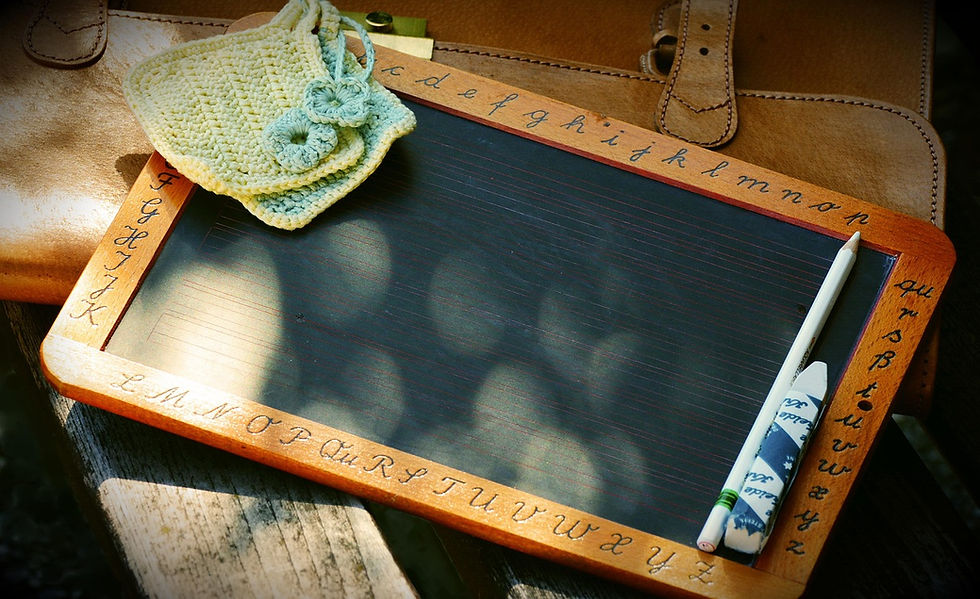The Fabric Wars: Cotton vs Polyester (Or, did you know that polyester is really plastic?)
- dhporterbooks
- Sep 13
- 5 min read
Beautiful fabrics last; synthetics don't. Certain fabrics, such as linen and cotton, develop their own character over time.
-- John Rocha
One of the pure pleasures I remember as a young girl was wearing a cotton dress or skirt and "twirling" around. The freedom, the cleanness, the "naturalness" of being a young girl without a care in the world, just me and my dress, was enough.

Fabrics and clothes bring back memories. There's a reason why Cotton used the tagline the fabric of our lives in their commercials. There's a reason why quilts were not only prized for their warmth and purpose in times past, but because they wove a story of memories - from a daughter's first dress, to a baby's first blanket, to a husband's work shirt and on and on.
As for the little girl in that dress, by the time she I was in her 40s, I was chronically ill, and at the same time, I had a sick child as well. I began going down several "rabbit holes" when it came to nutrition, health, big-Pharma, and more. I began to reflect on how people treated illnesses in the past. I wrote about my thyroid journey in my smallish book Will Someone Please Shoot the Cuckoo?, and I wrote about the eye-opening history of wheat and bread on a blog post "Nutrition and our Ancestors" on my genealogy site The Flying Shuttle.
Now, don't get me wrong. Modern medicine has its place. It has saved my life on at least two occasions. But there have been times it has cost me my health as well.
Recently, while learning that our skin is our largest organ, I began deep diving into what we wear and the kinds of things our "skin" comes in contact with. And then, a single phrase changed my world and set me onto another deep dive . . .
Polyester is really plastic.
What? I am wearing plastic?
Ugh . . .
Polyester became mainstream when I was about ten years old. My Mother, God bless her, latched onto it like a drowning woman. (That and the TV dinners that first were in foil.) She never researched what "polyester" was, and certainly would not have cared anyway if it was "plastic." Few people in the mid-70s gave plastic a thought. Researching was not something they did in the years before the internet.
As for my mother, she was just glad she no longer had to iron all those clothes.
Recently, I started paying attention to what I was wearing. I noticed I was "hot" in some fabrics regardless of the temperature. I felt like I couldn't breathe through my skin while wearing others. And I remembered how much I loved my "cotton" dresses and skirts while a girl, and how much I really did dislike being dressed in the newer materials, such as polyester and rayon.
But just what is polyester? (And ultimately rayon, nylon, jersey, and anything fabric younger than about 70 years?)
Polyester, as I stated earlier, is a type of fabric made from plastic. It’s cheap, it’s efficient, and it’s quite convenient since it doesn’t wrinkle, even if you wad it into a ball. Although it came to prominence in the 60s, its history reaches back to the mid-1930s.
W. H. Carother, a DuPont employee at the time, discovered he could create fibers my mixing carboxyl acids and alcohols. Although successful, this project was shelved when Carothers stumbled upon nylon, another fabric that is still incredibly popular today.
A few years later, in 1939, two British scientists, W.K. Birtwhistle and C.G. Ritchie, picked up where Carothers left off. But it wasn’t until 1941 that the very first true polyester fiber, called Terylene, came into existence. The pair continued their work until, in 1946, DuPont bought the rights from them.
Unlike other common and natural fabrics including cotton and wool, polyester was born of scientific research – and it was marketed with this idea in mind. In 1951 when it was presented to the American public, one of the selling points was the fact that it could be worn for 68 days straight without ironing or care and still look fresh. The fabric became a popular choice among women, who were the primary homemakers, because of its ease of use. By the 1960s, its fate was sealed among the masses, and its use has only grown throughout the last few decades.

Today's polyester, however, differs from the original. These days, science has refined the creation of polyester fabrics to the point that it can even look and feel like real silk. And, unfortunately, some designers are even recycling plastic bottles into polyester fabrics not just for clothing, but for home furnishings, carpeting, and even sleeping bags, umbrellas, and more. Its even used in fabric "blends," such as cotton and rayon.
Considering our skin is the largest organ in our body, I am not certain anyone has plumbed the depths of exactly what wearing plastic might be doing to us.
So Donna, at least, has been on a purge through closet and home. I threw out most of the polyester and rayon outfits, and I have vowed to buy no more. I look like a fruitcake checking all the labels when I shop, which is mostly thrift stores, but I do it anyway. I have even gotten really good at playing a game of "what is this made of" and most of the time winning - and winning bigly!
After suffering a bit on some sheets (a sleek, smooth polyester cotton blend) here at my Dad's house (they were hot and itchy), I was super excited to find 100% cotton bed sheets in the closet!
Yea, they were old. Yea, they were a good companion to the "linen" pillowcases I found in my closet that had originally been made by my grandmother. But they were real sheets born of a real fabric. They were cool. They weren't plastic. And boy, did I sleep good that night!
Now, I am on a quest for cotton dresses. Dresses that I could twirl in if I wished. Dresses that I would wear for the pure joy of how they make me feel.
What about you? Do you have a favorite memory of fabrics as a child? Drop me an email at donnahechlerporterbooks@gmail.com! I would love to hear about it!

About Donna
Donna Hechler Porter has always had stories in her head. When they were not swirling and gnawing, she had her head in a history book - both fiction and non-fiction. Now, she puts her love of old things, including her genealogy, to good use by writing both genealogy books and novels. She has published five historical novels, several of which have won awards, four genealogy books on her family history, and several smallish books including a book on the 1778 Big Siege of Fort Boonesborough and a book with tips and tricks for bringing history to life for young people. A graduate of Texas A & M University, she currently teaches middle school English and literature at a small private school east of Houston and runs a private tutoring business. She stops for all garage sales and to collect treasures from the side of the road. She dreams of life in a log cabin in the woods, even as she is addicted to antique and thrift shopping.
_________________________________________________________________________
If you live in southeast Texas and would like Donna to come speak at your reading, genealogy, or history club, please contact her. She is more than likely to say yes!
Need a topic for Donna to present? Check out her already created topics here or suggest one of your own.
_________________________________________________________________________
Sign up for Donna's newsletter "A Petticoat & A Pen" by clicking on the link below or scrolling back to the top of the page and clicking the link. You will get the first updates on my latest projects, tips for your own writing journey, insights into my writing world, and more! Best of all, a FREE gift is waiting for you at the other end!








Comments